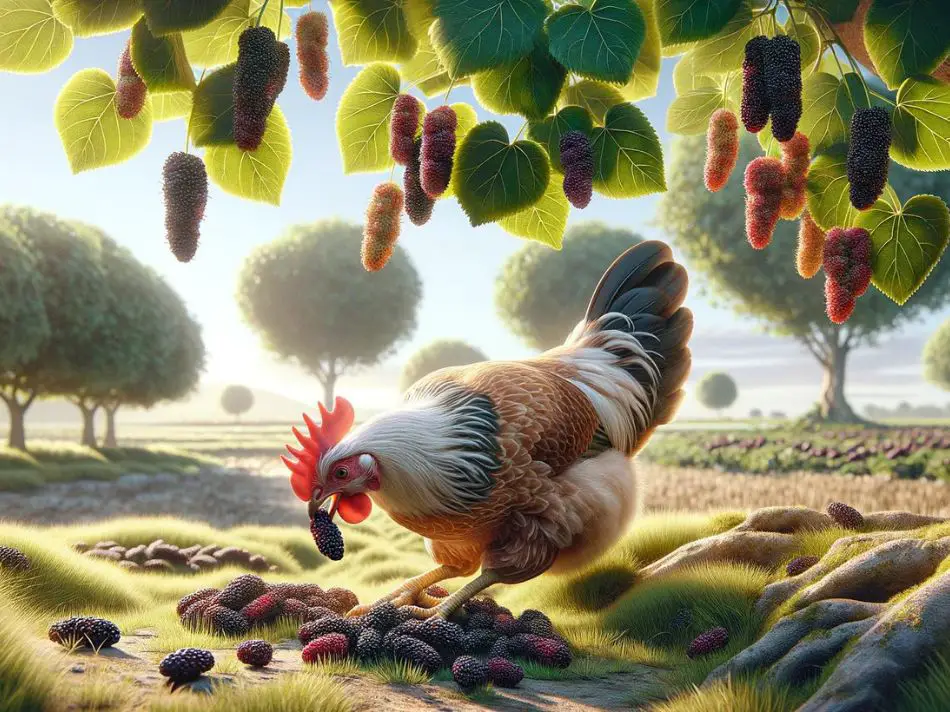Yes, chickens can eat mulberries. These berries are safe and nutritious for chickens, offering a variety of vitamins and minerals. However, they should be given in moderation as part of a balanced diet to ensure the health and well-being of the chickens.
| Key Aspect | Details |
|---|---|
| Frequency of Feeding | Feed mulberries once or twice a week. |
| Nutritional Benefits | Rich in vitamins (C, K, E, A) and minerals (Iron, Potassium, Magnesium). |
| Risks | Overfeeding can cause digestive issues and obesity; avoid spoiled or pesticide-contaminated berries. |
| Feeding Method | Wash thoroughly, offer in moderation, mix with other foods, and monitor reactions. |
| Storage | Keep unused portions in a cool, dry place. |
| Overall Recommendation | Include mulberries as a part of a balanced and varied diet for chickens. |
Discover how often chickens can enjoy mulberries, their nutritional benefits, and potential risks. Learn the best ways to incorporate mulberries into their diet. We’ll also explore other nuts suitable for chickens, ensuring you’re well-informed about feeding these treats to your feathered friends.
How Often Can I Feed My Chickens Mulberries?
Feeding mulberries to chickens should be done in moderation. Treat mulberries as a snack, not as a staple of their diet. It’s recommended to feed chickens mulberries once or twice a week.
This frequency makes sure they enjoy the benefits of these berries without overconsumption. Balancing mulberries with their regular feed and other treats is crucial for maintaining a healthy and varied diet.
Nutritional Value for Mulberries
Nutritional Composition of Mulberries per 100 grams
| Nutrient | Amount |
|---|---|
| Protein | 1.44 g |
| Fat | 0.39 g |
| Vitamins | Vitamin C, Vitamin K, Vitamin E, Vitamin A |
| Minerals | Iron, Potassium, Magnesium |
Nutritional Benefits of Mulberries for Chickens
Protein: A moderate protein source, mulberries contribute to muscle development and overall health in chickens. They provide essential amino acids necessary for feather growth and bodily functions.
Fat: With a low fat content, mulberries are a healthy snack for chickens, reducing the risk of obesity while providing essential fatty acids.
Vitamin C: Acts as an immune booster, helping chickens combat stress and various diseases. It also aids in the absorption of iron, enhancing overall health.
Vitamin K: Essential for blood clotting and bone health. Vitamin K ensures chickens maintain strong bones and a healthy circulatory system.
Vitamin E: As an antioxidant, it protects cells from oxidative stress, supporting immune function and overall well-being.
Vitamin A: Important for vision, growth, and reproductive health. It plays a crucial role in maintaining good eyesight and robust feather condition.
Iron: Supports healthy blood and energy levels, contributing to the overall vitality of chickens. Iron is vital for hemoglobin formation, which transports oxygen in the blood.
Potassium: Necessary for proper heart function, muscle contractions, and nerve signaling. It helps in maintaining fluid balance and muscle health in chickens.
Magnesium: Aids in muscle and nerve function, enzyme activation, and bone development. Magnesium is important for energy metabolism and protein synthesis in chickens.
These nutrients in mulberries contribute significantly to the health and well-being of chickens, promoting growth, immune function, and overall vitality. While they should not replace a chicken’s primary diet, mulberries serve as a healthy, nutrient-rich treat.
Risks Of Eating Mulberries For Chickens
Overfeeding mulberries to chickens can lead to digestive issues and nutritional imbalances. Their high sugar content can contribute to obesity if consumed excessively.
Additionally, feeding spoiled or pesticide-contaminated mulberries can be harmful. Moderation is key to avoid these risks.
How To Feed Mulberries To Chickens
- Select Fresh Mulberries: Choose ripe, fresh mulberries that are free from mold or spoilage.
- Wash Thoroughly: Rinse the mulberries under clean water to remove any dirt or potential pesticide residue.
- Offer in Small Quantities: Introduce mulberries as a treat, not a staple in their diet. A handful per chicken is sufficient.
- Monitor First-Time Feedings: Observe your chickens for any adverse reactions when feeding mulberries for the first time.
- Mix with Other Foods: You can combine mulberries with their regular feed or other fruits and vegetables for variety.
- Avoid Overfeeding: Limit the frequency of feeding mulberries to prevent digestive issues and maintain a balanced diet.
- Chop for Smaller Breeds: For bantam or smaller chicken breeds, consider chopping the mulberries into smaller pieces.
- Remove Uneaten Berries: Clear any uneaten mulberries from the coop to avoid attracting pests and to maintain hygiene.
- Store Properly: Keep any unused mulberries in a cool, dry place or refrigerate to preserve their freshness for later use.
More Berries Chickens Can Eat
Chickens can safely enjoy a variety of berries besides mulberries. These berries are not only delicious treats for your chickens but also provide them with additional vitamins and antioxidants.
It’s important to feed these in moderation and always ensure they are fresh and pesticide-free. Introducing a range of berries can add nutritional diversity to their diet and stimulate their foraging behavior.
- Blueberries
- Raspberries
- Blackberries
- Cranberries (unsweetened)
- Elderberries (cooked)
Conclusion
In conclusion, mulberries are a safe and beneficial treat for chickens when given in moderation.
By understanding their nutritional benefits and potential risks, and following proper feeding guidelines, you can confidently include mulberries in your chickens’ diet.
Exploring other berry options further diversifies their diet, promoting overall health and happiness in your poultry.
Remember, a varied diet is key to raising healthy, thriving chickens.
Disclaimer: The information in this article is for informational purposes only. I'm not an expert or a veterinarian.


